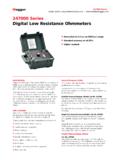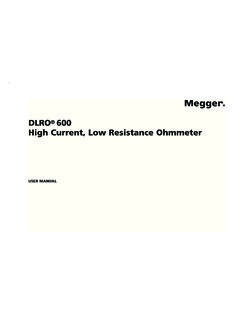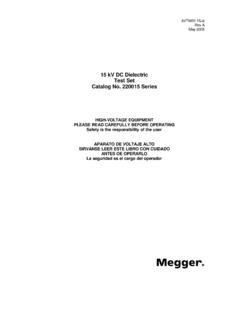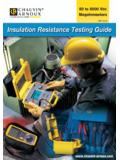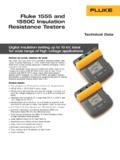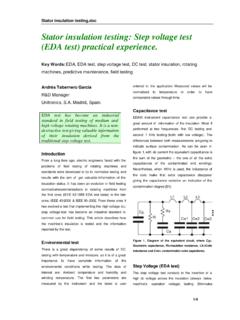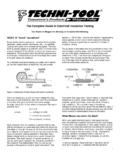Transcription of GBP £5.95 “A Stitch in Time” - BiddleMegger.com
1 A Stitch IN time A Stitch in US $ Complete Guide to Electrical insulation Testing A Stitch IN time A Stitch In time The Complete Guide to Electrical insulation TestingCopyright 2006 A Stitch IN TIMEConTEnTS PAGEWHAT IS Good insulation ? .. 3 WHAT MAkeS insulation Go BAd? .. 4 HoW insulation resistance IS MeASURed .. 5 HoW To InTeRPReT resistance ReAdInGS .. 6 FACToRS AFFeCTInG insulation resistance ReAdInGS .. 8 TyPeS oF insulation resistance TeSTS .. 10 TeST VolTAGe VS. eqUIPMenT RATInG .. 16AC TeSTInG VS. dC .. 17 USe oF dC dIeleCTRIC TeST SeT .. 18 TeSTS dURInG dRyInG oUT oF eqUIPMenT .. 18eFFeCT oF TeMPeRATURe on insulation 21eFFeCTS oF HUMIdITy .. 23 PRePARATIon oF APPARATUS To TeST .. 24 SAFeTy PReCAUTIonS .. 26 ConneCTIonS FoR TeSTInG insulation resistance oF eleCTRICAl eqUIPMenT .. 27 AddITIonAl noTeS ABoUT USInG A MeGGeR insulation TeSTeR .. 33 InTeRPReTATIon-MInIMUM VAlUeS .. 36 MInIMUM VAlUeS FoR insulation resistance .
2 38 TeSTS USInG MUlTI-VolTAGe MeGGeR insulation TeSTeRS .. 42 STeP-VolTAGe MeTHod .. 48 USe oF A GUARd TeRMInAl .. 50 BUSHInGS, PoTHeAdS And InSUlAToRS .. 54oUTdooR oIl CIRCUIT BReAkeRS .. 57 SeTTInG UP A MAInTenAnCe PRoGRAM .. 60 HoW oFTen SHoUld yoU TeST? .. 60 MeGGeR 5 And 10 kV insulation TeSTeRS .. 62 A Stitch IN time WHAT IS Good insulation ?every electric wire in your plant whether it s in a motor, generator, cable, switch, transformer, etc. is carefully covered with some form of electrical insulation . The wire itself is usually copper or aluminum, which is known to be a good conductor of the electric current that powers your equipment. The insulation must be just the opposite from a conductor: it should resist current and keep the current in its path along the conductor. To understand insulation testing you really don t need to go into the mathematics of electricity, but one simple equation ohm s law can be very helpful in appreciating many aspects.
3 Even if you ve been exposed to this law before, it may be a good idea to review it in the light of insulation purpose of insulation around a conductor is much like that of a pipe carrying water, and ohm s law of electricity can be more easily understood by a comparison with water flow. In Fig. 1 we show this comparison. Pressure on water from a pump causes flow along the pipe (Fig. 1a). If the pipe were to spring a leak, you d waste water and lose some water pressure. With electricity, voltage is like the pump pressure, causing electricity to flow along the copper wire (Fig. 1b). As in a water pipe, there is some resistance to flow, but it is much less along the wire than it is through the 1 Comparison of water flow (a) with electric current (b). A Stitch IN TIMEC ommon sense tells us that the more voltage we have, the more current there ll be. Also, the lower the resistance of the wire, the more current for the same voltage. Actually, this is ohm s law, which is expressed this way in equation form: e = I x Rwhere, e = voltage in volts I = current in amperes R = resistance in ohmsnote, however, that no insulation is perfect (that is, has infinite resistance ) so some electricity does flow along the insulation or through it to ground.
4 Such a current may only be a millionth of an ampere (one microampere) but it is the basis of insulation testing equipment. note also that a higher voltage tends to cause more current through the insulation . This small amount of current would not, of course, harm good insulation but would be a problem if the insulation has , to sum up our answer to the question what is good insulation ? We have seen that, essentially, good means a relatively high resistance to current. Used to describe an insulation material, good would also mean the ability to keep a high resistance . So, a suitable way of measuring resistance can tell you how good the insulation is. Also, if you take measurements at regular periods, you can check trends toward its deterioration (more on this later).WHAT MAkES insulation Go BAd?When your plant electrical system and equipment are new, the electrical insulation should be in top notch shape. Furthermore, manufacturers of wire, cable, motors, and so on have continually improved their insulations for services in industry.
5 Nevertheless, even today, insulation is subject to many effects which can cause it to fail mechanical damage, vibration, excessive heat or cold, dirt, oil, corrosive vapors, moisture from processes, or just the humidity on a muggy various degrees, these enemies of insulation are at work as time goes on combined with the electrical stresses that exist. As pin holes or cracks develop, moisture and foreign matter penetrate the surfaces of the insulation , providing a low resistance path for leakage current. A Stitch IN time once started, the different enemies tend to aid each other, permitting excessive current through the the drop in insulation resistance is sudden, as when equipment is flooded. Usually, however, it drops gradually, giving plenty of warning, if checked periodically. Such checks permit planned reconditioning before service failure. If there are no checks, a motor with poor insulation , for example, may not only be dangerous to touch when voltage is applied, but also be subject to burn out.
6 What was good insulation has become a partial conductor. HoW insulation resistance IS MEASuREdyou have seen that good insulation has high resistance ; poor insulation , relatively low resistance . The actual resistance values can be higher or lower, depending upon such factors as the temperature or moisture content of the insulation ( resistance decreases in temperature or moisture). With a little record-keeping and common sense, however, you can get a good picture of the insulation condition from values that are only Megger insulation tester is a small, portable instrument that gives you a direct reading of insulation resistance in ohms or megohms. For good insulation , the resistance usually reads in the megohm Megger insulation tester is essentially a high-range resistance meter (ohmmeter) with a built-in direct-current generator. This meter is of special construction with both current and voltage coils, enabling true ohms to be read directly, independent of the actual voltage applied.
7 This method is non-destructive; that is, it does not cause deterioration of the 2 Typical Megger test instrument hook-up to measure insulation resistance . A Stitch IN TIMEThe generator can be hand-cranked or line-operated to develop a high dC voltage which causes a small current through and over surfaces of the insulation being tested (Fig. 2). This current (usually at an applied voltage of 500 volts or more) is measured by the ohmmeter, which has an indicating scale. Fig. 3 shows a typical scale, which reads increasing resistance values from left up to infinity, or a resistance too high to be 4 Typical record of insulation resistance of a mill motor. Curve A shows test values as measured; Curve B shows same values corrected to 20 C (see page 22), giving a definite downward trend toward an unsafe condition. Reverse side of card (at right) is used to record the test 3 Typical scale on the Megger insulation To InTERPRET resistance REAdInGSAs previously mentioned, insulation resistance readings should be considered relative.
8 They can be quite different for one motor or machine tested three days in a row, yet not mean bad insulation . What really matters is the trend in readings over a time period, showing lessening resistance and warning of coming problems. Periodic testing is, therefore, your best approach to preventive maintenance of electrical equipment, using record cards as shown in Fig. 4. A Stitch IN time Whether you test monthly, twice a year, or once a year depends upon the type, location, and importance of the equipment. For example, a small pump motor or a short control cable may be vital to a process in your plant. experience is the best teacher in setting up the scheduled periods for your equipment. you should make these periodic tests in the same way each time . That is, with the same test connections and with the same test voltage applied for the same length of time . Also you should make tests at about the same temperature, or correct them to the same temperature.
9 A record of the relative humidity near the equipment at the time of the test is also helpful in evaluating the reading and trend. later sections cover temperature correction and humidity summary, here are some general observations about how you can interpret periodic insulation resistance tests, and what you should do with the result: Condition What To do(a) Fair to high values no cause for concern. and well maintained. (b) Fair to high values, locate and remedy the cause and but showing a check the downward trend. constant tendency towards lower values. (c) low but well maintained. Condition is probably all right, but cause of low values should be checked. (d) So low as to be unsafe. Clean, dry out, or otherwise raise the values before placing equipment in service. (Test wet equipment while drying out.) (e) Fair or high values, Make tests at frequent intervals until previously well the cause of low values is located maintained but showing and remedied; or until the values sudden lowering.
10 Have become steady at a lower level but safe for operation; or until values become so low that it is unsafe to keep the equipment in operation. A Stitch IN TIMEFACToRS AFFECTInG insulation resistance REAdInGSRemember that the measured resistance (of the insulation ) will be determined by the voltage applied and the resultant current (R = e/I). There are a number of things that affect current, including temperature of the insulation and humidity, as mentioned in the previous section. Right now, let s just consider the nature of current through insulation and the effect of how long voltage is applied. Current through and along insulation is made up partly of a relatively steady current in leakage paths over the insulation surface. electricity also flows through the volume of the insulation . Actually, as shown in Fig. 5, our total current comprises three components:1. Capacitance Charging Current Current that starts out high and drops after the insulation has been charged to full voltage (much like water flow in a garden hose when you first turn on the spigot).



